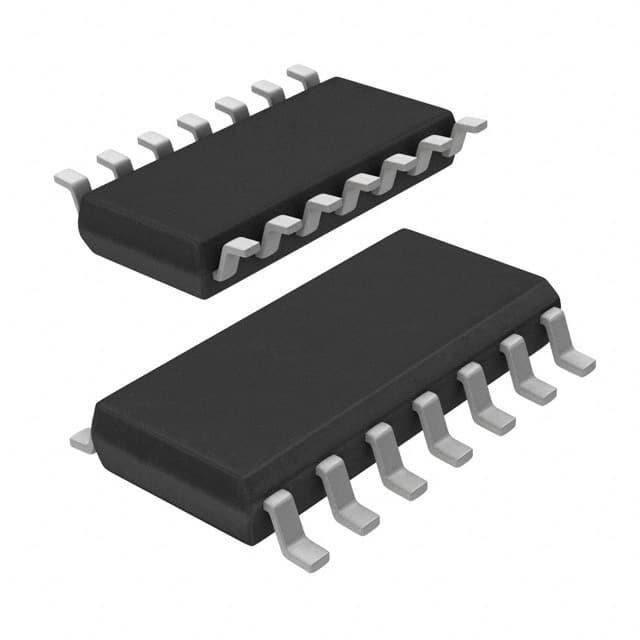Viz Specifikace pro podrobnosti o produktu.

74LV393D,112
Product Overview
Category
The 74LV393D,112 belongs to the category of integrated circuits (ICs).
Use
This IC is commonly used in digital electronic circuits for various applications.
Characteristics
- Low-voltage operation
- High-speed performance
- Dual 4-bit binary ripple counter
Package
The 74LV393D,112 is available in a small outline package (SO) with 14 pins.
Essence
The essence of this product lies in its ability to count and store binary data in digital circuits.
Packaging/Quantity
The 74LV393D,112 is typically packaged in reels or tubes, with a quantity of 2500 units per reel/tube.
Specifications
- Supply voltage: 2.0V to 5.5V
- Operating temperature range: -40°C to +125°C
- Maximum clock frequency: 100MHz
- Output current: ±6mA
- Input voltage levels: CMOS/TTL compatible
Detailed Pin Configuration
- Clock input A (CLKA)
- Clock input B (CLKB)
- Reset input (RST)
- Counter output Q0
- Counter output Q1
- Counter output Q2
- Counter output Q3
- Ground (GND)
- Counter output Q3̅
- Counter output Q2̅
- Counter output Q1̅
- Counter output Q0̅
- Carry output (COUT)
- Supply voltage (VCC)
Functional Features
- Dual 4-bit binary ripple counter with individual clock inputs
- Asynchronous reset functionality
- Outputs can be cascaded for larger counter configurations
- Low power consumption
- Wide operating voltage range
Advantages and Disadvantages
Advantages
- High-speed operation allows for efficient counting in digital circuits
- Low-voltage operation enables compatibility with various systems
- Asynchronous reset feature provides flexibility in circuit design
- Compact package size saves board space
Disadvantages
- Limited maximum clock frequency compared to some other ICs
- Output current is relatively low, which may restrict certain applications
Working Principles
The 74LV393D,112 operates as a dual 4-bit binary ripple counter. It counts input clock pulses and stores the binary count in its internal registers. The asynchronous reset input allows for resetting the counter to a specific value. The outputs represent the binary count in both normal and complement form.
Detailed Application Field Plans
The 74LV393D,112 finds application in various digital electronic systems, including but not limited to: - Digital counters - Frequency dividers - Time delay circuits - Event sequencing - Data encoding/decoding
Detailed and Complete Alternative Models
Some alternative models that offer similar functionality to the 74LV393D,112 include: - 74HC393: High-speed CMOS version - CD40193: CMOS version with additional features - SN74LS393: TTL version with different voltage levels
(Note: This list is not exhaustive and there are other alternatives available in the market.)
In conclusion, the 74LV393D,112 is a versatile integrated circuit used in digital electronic circuits for counting and storing binary data. Its high-speed performance, low-voltage operation, and compact package make it suitable for various applications. However, it has limitations in terms of maximum clock frequency and output current. Understanding its pin configuration, functional features, advantages, disadvantages, working principles, and alternative models helps in utilizing this IC effectively in different application fields.
Seznam 10 běžných otázek a odpovědí souvisejících s aplikací 74LV393D,112 v technických řešeních
Sure! Here are 10 common questions and answers related to the application of 74LV393D,112 in technical solutions:
Q: What is the function of the 74LV393D,112? A: The 74LV393D,112 is a dual 4-bit binary ripple counter that can be used for various counting applications.
Q: What is the maximum clock frequency supported by the 74LV393D,112? A: The 74LV393D,112 can support clock frequencies up to 100 MHz.
Q: How many outputs does the 74LV393D,112 have? A: The 74LV393D,112 has two independent 4-bit ripple counters, so it has a total of eight outputs.
Q: Can the 74LV393D,112 be cascaded to create larger counters? A: Yes, multiple 74LV393D,112 chips can be cascaded together to create larger counters with more bits.
Q: What is the power supply voltage range for the 74LV393D,112? A: The 74LV393D,112 operates with a power supply voltage range of 2.0V to 5.5V.
Q: Does the 74LV393D,112 have any built-in asynchronous clear functionality? A: No, the 74LV393D,112 does not have a built-in asynchronous clear feature.
Q: Can the 74LV393D,112 be used in both synchronous and asynchronous counting modes? A: Yes, the 74LV393D,112 can be used in both synchronous and asynchronous counting modes depending on the application requirements.
Q: What is the typical propagation delay of the 74LV393D,112? A: The typical propagation delay of the 74LV393D,112 is around 5 ns.
Q: Can the 74LV393D,112 be used in high-speed applications? A: Yes, the 74LV393D,112 is designed for high-speed operation and can be used in various high-speed applications.
Q: Are there any specific precautions to consider when using the 74LV393D,112? A: It is important to ensure proper decoupling capacitors are used near the power supply pins to minimize noise and voltage fluctuations. Additionally, care should be taken to avoid exceeding the maximum ratings specified in the datasheet.
Please note that these answers are general and may vary depending on the specific application and requirements.

